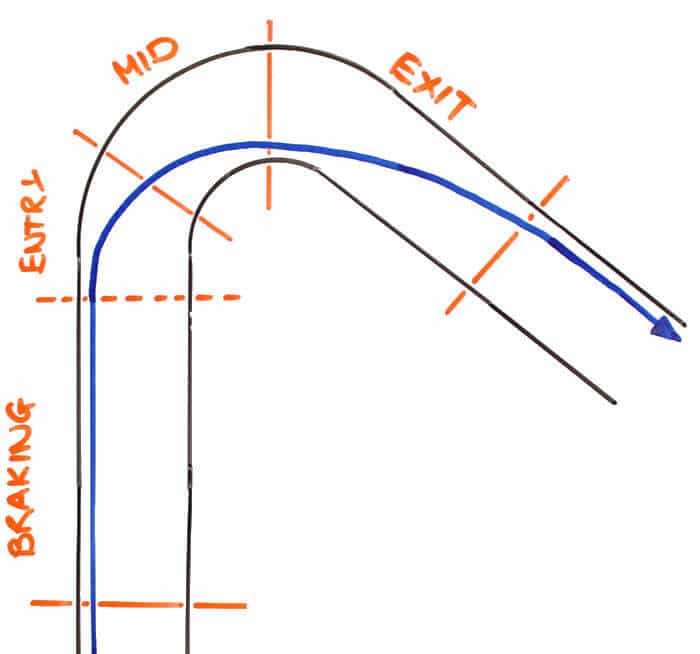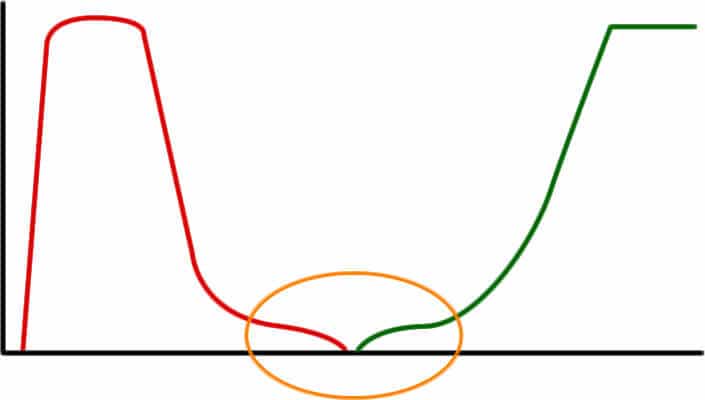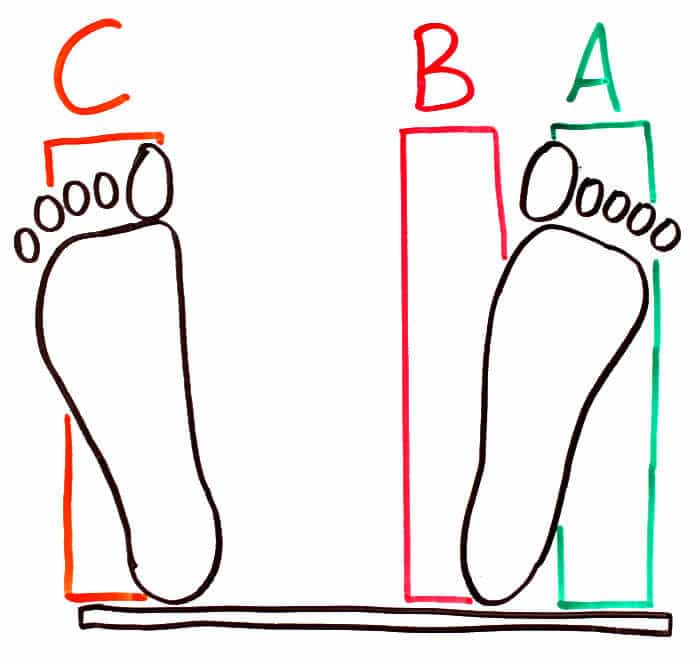The mid-corner phase requires a smooth transition from the brake pedal to the throttle, to keep weight transfer at a minimum and maintain overall grip levels at their maximum.
Welcome to Tutorial #14 in the Driver’s University series, How to Maximise the Mid-Corner Phase.
Today’s tutorial will cover:
- What is the mid-corner phase?
- How to be fast in the mid-corner phase
- Why do we need to be so smooth?
- Transitioning from the brake to the throttle pedal
- How to improve and where to focus your efforts
Save & Exit
What Is the Mid-Corner Phase?
The mid-corner phase is where the car is turning with most lateral G-force and the area where the driver is transitioning from the brake pedal to the throttle pedal.
There a lot going on with the car in the mid-corner phase. The lateral load – or turning force – going through the car peaks in this area and the weight of the vehicle is transferring from the front to the rear.

How to Be Fast in the Mid-Corner Phase
With all of this weight moving around the car, it’s critical that we’re silky smooth throughout this phase.
As I spoke about in the weight transfer tutorial, the more weight transfer a driver creates in their car, the lower the overall grip level is. If you need a refresh on this principle, please watch the video tutorial here.
Therefore, at this point in the corner – where the driver is transferring weight around the car with his inputs through the pedals – he must do it as smoothly as possible. Any sharp movements here moves too much weight, reduces overall grip levels and ensures a lower than optimum cornering speed.

The chart above shows a brake and throttle pedal trace, copied from my own data. The graph describes the brake pressure and throttle position throughout the whole corner: braking, entry, mid-corner and exit. However, we’re focusing on the circled section – this is the mid-corner part of the turn.
As you can see, brake pressure has decreased significantly and as I spoke about in the trail braking tutorial, the pressure is not so much to slow the car, but rather to control the pitch, weight transfer and grip balance.
This is the area where it’s critical to ‘bleed’ off the brakes smoothly. To ‘bleed’ off the pressure means to come off ever so gently, as you can see in the graph.
Once we’ve bled off the brakes with great finesse, we need to be ready to get back on the throttle.
The engagement of the throttle should be similar to the mirror of the brake release. However, it depends on the type of corner, and it can also be affected by how you’ve entered the turn.
In any case, the application of the throttle needs to be, as always, silky smooth.
Sometimes, you can get back on the throttle quickly after the brake release, other times you’ll need to wait and be patient. But what’s consistent is that there’ll be a period – as you can see on the graph – where the throttle percentage is low.
The throttle pedal is not a switch, and it must not be used in this way.
The graph shows a period where I am using maybe, 10 or 15% of the throttle. In this area, I am re-engaging the engine as smoothly as possible, again so that we don’t unsettle the car. The car is not accelerating at this point, merely maintaining a constant speed.
As I spoke about in our grip tutorial, the car is cornering with maximum force in this mid-corner phase. Therefore, the tyre’s grip is being used entirely for turning – not deceleration or acceleration and so a smooth application of the throttle is critical. Anything harsher will cause an unwanted breaking of traction as the tyre should already be at its grip threshold.
Once we’ve engaged the throttle, we’ll begin to open the steering angle and accelerate, but that’s next week’s tutorial.
Why Do We Need to Be So Smooth?
As I touched on earlier – and as I mention in most articles – to be fast, you need to be smooth. The reason, in this case, is that any weight transfer (the movement of mass around the car’s suspension) creates a reduction in overall grip levels.
Therefore, to lap as quickly as possible we need to keep weight transfer at a minimum.
Imagine arriving at a corner and turning the steering wheel into the apex as hard as you can. Hopefully, this would seem unnatural and make you feel a little nervous.
If you turn in this way, the car’s weight transfers hard and fast to the outside tyres and would cause a premature break in traction. It’s the same concept with your brake and throttle inputs.
If in this mid-corner phase, you release the brakes quickly, the front of the car will rise up promptly, causing a fast transfer of weight. This, in turn, will ruin the balance of the car.
It’s much better (and faster) to bleed off the brakes, allow the front to rise gently while maintaining control and using all of the grip available from the tyres.
The same is accurate with the throttle pedal inputs. Once the brakes have been released, and you’re ready to reapply the throttle, don’t just go flat out as quickly as possible.
This would shock the driven tyres and could cause a whole host of difficulties. The correct technique is to gently apply the first 10-20% of the throttle, allow the car to settle, then increase throttle as you exit the corner.
With this smoother technique there is much less weight transferring around the car, and so you maintain a higher overall grip level – meaning higher cornering speeds and a faster lap time.
Transitioning From the Brake to the Throttle Pedal
With your finesse and transition from brake to throttle being so critical to sound technique, it’s important we have the pedals set up correctly, and your feet are positioned and anchored properly.
Most drivers will use their right foot for both accelerating and braking. For most people, this technique is faster, as they don’t have the feel in their left foot to brake and trail brake properly, resulting in ‘clunky’ and harsh inputs.
If you have a manual track car, I wouldn’t worry about even trying left-foot-braking, as the clutch will take up the majority of your left foot’s time.
If you have paddle shift, left foot braking can be faster, but only if you have excellent feel in your left foot – often built up over many years. We’re going to cover the pros, cons and technique of left foot braking later in this series.
The next thing to consider – if you’re using your right foot for braking and acceleration – is that your heel should be grounded somewhere between both pedals.

I recently worked with a driver who was lifting his entire foot away from the accelerator (heel and all), before then placing it back on the brake pedal. Not only does this movement take quite a lot of time, but you also lose a lot of precision when your foot is moving around so much.
So keep your heel on the floor (preferably on a heel rest) and pivot your foot around this point. Keeping your foot on the deck will give you much more control between the pedals and allow for a smoother and faster transition.
If you drive a new car or even after a while of not driving on track, jump in the car before your first session (with your race boots on) and try out this transition. Imagine you’re driving on the circuit and move your feet accordingly.
This will allow you to check that the pedals are set up correctly and enable you to perfect the transition between the two. It’s a simple process, but it’ll mean that you won’t have any problems out on the circuit, and you’ll already know how the pedals feel.
As the mid-corner phase of the corner requires such a delicate touch, the soft inputs needed should be practised as much as possible.
As with some other techniques, it’s worthwhile (and safe) to practice the smooth transition between pedals in your road car.
When practising, try to ‘bleed’ of the brake pedal, noticing any sudden rise in the front of the car and trying to keep it as smooth as possible. If you feel the front of the car ‘pop’ up as you release the brakes, you’ve released them too quickly.
Then, get back on the throttle delicately – think about the throttle trace from earlier, with the small percentage for a while, before we begin to accelerate. Again, if you feel the car jerk forwards, you’ve got on the pedal to harshly.
With both the brake release and initial throttle application, you should not feel any inputs; they must flow into each other.
How to Improve and Where to Focus
As with a lot of precise technique, we firstly need to ensure our fundamental techniques are correct.
Good vision is a necessity for the perfect racing line and carrying the correct speed into a corner, both of which will directly affect the mid-corner phase.
To give yourself the best opportunity to be fast, make sure your vision is towards the exit of the turn, at this mid-corner phase. For more on vision, see our tutorial here.
As I’ve mentioned throughout this tutorial, and website, smoothness is so important – especially in the mid-corner phase. Ensure your inputs are soft, not necessarily slow, but with a fluidness to them so the car flows through the corner, without any harsh spikes.
A common mistake through this phase is when drivers get on the throttle too soon. The mid-corner can last for quite a long time, so if you feel like you’re running out of road on the corner exit, it’s likely that you’re trying too hard and have got on the throttle too soon.
In this case, again make sure your vision is sound, and that you focus on carrying as much speed at the exit as possible. After all, any extra speed you carry out the corner will accumulate all the way down the following straight and improve your lap time significantly.
That’s all for today’s tutorial, thanks for reading. Look out for next week’s tutorial and the final in this mini-series – Maximising The Exit Phase. If you enjoyed this article, please share it with your social media and I’ll see you next week, Scott.
